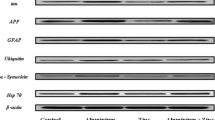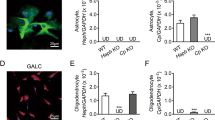Abstract
Copper and iron dyshomeostasis has been implicated directly or indirectly in the pathogenesis of neurodegenerative diseases. Previously, we have shown the first in vivo evidence of significant increase in the hippocampus copper and zinc content with spatial memory impairments, astrocytes swelling (Alzheimer type-II cells) coupled with increase in the number of astrocytes, copper deposition in the choroid plexus, and degenerated neurons in copper-intoxicated Wistar rats. In continuation with our previous study, the aim of this study was to further investigate the effects of intraperitoneally injected copper lactate (0.15 mg Cu/100 g body weight) daily for 90 days on serum “free” copper levels, iron levels in the liver, and hippocampus by atomic absorption spectrophotometry and histopathological study of the liver and brain tissues of Wistar rats using Perls' Prussian blue (PPB) stain. A massive significant increase in serum “free” copper (79.48 % increase) along with strong correlation (r = 0.978) was found between serum copper and serum “free” copper in copper-intoxicated rats. No significant difference was detected in hepatic and hippocampus iron levels between control and copper-intoxicated rats. PPB stain demonstrated very few scattered grade 1 haemosiderin deposits within sinusoidal cells predominantly Kupffer cells; however, brain sections were negatively stained with PPB stain. In conclusion, the current study demonstrates that chronic copper toxicity causes increase in serum “free” copper, which may serve as predisposing factor for the development of neurodegeneration and memory deficits, and grade 1 haemosiderin deposition in Kupffer cells without altering hepatic and hippocampus iron levels in male Wistar rats.





Similar content being viewed by others
References
Zheng W, Monnot AD (2012) Regulation of brain iron and copper homeostasis by brain barrier systems: implication in neurodegenerative diseases. Pharmacol Ther 133(2):177–188. doi:10.1016/j.pharmthera.2011.10.006
Georgopoulos PG, Roy A, Yonone-Lioy MJ, Opiekun RE, Lioy PJ (2001) Environmental copper: its dynamics and human exposure issues. J Toxicol Environ Health B Crit Rev 4(4):341–394. doi:10.1080/109374001753146207
Rivera-Mancia S, Perez-Neri I, Rios C, Tristan-Lopez L, Rivera-Espinosa L, Montes S (2010) The transition metals, copper, and iron in neurodegenerative diseases. Chem Biol Interact 186(2):184–199. doi:10.1016/j.cbi.2010.04.010
Gambling L, McArdle HJ (2004) Iron, copper, and fetal development. Proc Nutr Soc 63(4):553–562
Sharp P (2004) The molecular basis of copper and iron interactions. Proc Nutr Soc 63(4):563–569
Ranganathan PN, Lu Y, Jiang L, Kim C, Collins JF Serum ceruloplasmin protein expression and activity increases in iron-deficient rats and is further enhanced by higher dietary copper intake. Blood 118(11):3146–3153. doi:10.1182/blood-2011-05-352112
Squitti R, Ventriglia M, Barbati G, Cassetta E, Ferreri F, Dal Forno G, Ramires S, Zappasodi F, Rossini PM (2007) 'Free' copper in serum of Alzheimer's disease patients correlates with markers of liver function. J Neural Transm 114(12):1589–1594. doi:10.1007/s00702-007-0777-6
Kristinsson J, Snaedal J, Torsdottir G, Johannesson T Ceruloplasmin and iron in Alzheimer's disease and Parkinson's disease: a synopsis of recent studies. Neuropsychiatr Dis Treat 8:515–521. doi:10.2147/NDT.S34729
Brewer GJ, Kanzer SH, Zimmerman EA, Celmins DF, Heckman SM, Dick R Copper and ceruloplasmin abnormalities in Alzheimer's disease. Am J Alzheimers Dis Other Demen 25(6):490–497. doi:10.1177/1533317510375083
Brewer GJ (2010) Risks of copper and iron toxicity during aging in humans. Chem Res Toxicol 23(2):319–326. doi:10.1021/tx900338d
Desai V, Kaler SG (2008) Role of copper in human neurological disorders. Am J Clin Nutr 88(3):855S–858S
Salustri C, Barbati G, Ghidoni R, Quintiliani L, Ciappina S, Binetti G, Squitti R (2010) Is cognitive function linked to serum free copper levels? A cohort study in a normal population. Clin Neurophysiol 121(4):502–507. doi:10.1016/j.clinph.2009.11.090
Sparks DL, Schreurs BG (2003) Trace amounts of copper in water-induce beta-amyloid plaques and learning deficits in a rabbit model of Alzheimer's disease. Proc Natl Acad Sci U S A 100(19):11065–11069. doi:10.1073/pnas.1832769100
Lu J, Zheng YL, Wu DM, Sun DX, Shan Q, Fan SH (2006) Trace amounts of copper induce neurotoxicity in the cholesterol-fed mice through apoptosis. FEBS Lett 580(28–29):6730–6740. doi:10.1016/j.febslet.2006.10.072
Mao X, Ye J, Zhou S, Pi R, Dou J, Zang L, Chen X, Chao X, Li W, Liu M, Liu P (2012) The effects of chronic copper exposure on the amyloid protein metabolism associated genes' expression in chronic cerebral hypoperfused rats. Neurosci Lett. doi:10.1016/j.neulet.2012.04.030
An L, Liu S, Yang Z, Zhang T Cognitive impairment in rats induced by nano-CuO and its possible mechanisms. Toxicol Lett 213(2):220–227. doi:10.1016/j.toxlet.2012.07.007
Pal A, Badyal RK, Vasishta RK, Attri SV, Thapa BR, Prasad R Biochemical, Histological, and Memory Impairment Effects of Chronic Copper Toxicity: A Model for Non-Wilsonian Brain Copper Toxicosis in Wistar Rat. Biol Trace Elem Res. doi:10.1007/s12011-013-9665-0
Narasaki M (1980) Laboratory and histological similarities between Wilson's disease and rats with copper toxicity. Acta Med Okayama 34(2):81–90
Scriver CR (1995) The Metabolic Basis of Inherited Disease. McGraw-Hill Information Services Company
European Association for Study of L EASL Clinical Practice Guidelines: Wilson's disease. J Hepatol 56 (3):671–685. doi:10.1016/j.jhep.2011.11.007
Prasad R, Kaur G, Walia BN (1998) A critical evaluation of copper metabolism in Indian Wilson's disease children with special reference to their phenotypes and relatives. Biol Trace Elem Res 65(2):153–165. doi:10.1007/bf02784267
Bancroft JD, Gamble M (2008) Theory and Practice of Histological Techniques. Elsevier Science Health Science Division
Hall AP, Davies W, Stamp K, Clamp I, Bigley A Comparison of Computerized Image Analysis with Traditional Semiquantitative Scoring of Perls' Prussian Blue Stained Hepatic Iron Deposition. Toxicol Pathol. doi:10.1177/0192623313476576
Scheuer PJ, Williams R, Muir AR (1962) Hepatic pathology in relatives of patients with haemochromatosis. J Pathol Bacteriol 84:53–64
Barry M (1974) Liver iron concentration, stainable iron, and total body storage iron. Gut 15(5):411–415
Squitti R, Barbati G, Rossi L, Ventriglia M, Dal Forno G, Cesaretti S, Moffa F, Caridi I, Cassetta E, Pasqualetti P, Calabrese L, Lupoi D, Rossini PM (2006) Excess of nonceruloplasmin serum copper in AD correlates with MMSE, CSF [beta]-amyloid, and h-tau. Neurology 67(1):76–82. doi:10.1212/01.wnl.0000223343.82809.cf
Squitti R, Pasqualetti P, Dal Forno G, Moffa F, Cassetta E, Lupoi D, Vernieri F, Rossi L, Baldassini M, Rossini PM (2005) Excess of serum copper not related to ceruloplasmin in Alzheimer's disease. Neurology 64(6):1040–1046. doi:10.1212/01.wnl.0000154531.79362.23
Arnal N, Cristalli DO, de Alaniz MJ, Marra CA Clinical utility of copper, ceruloplasmin, and metallothionein plasma determinations in human neurodegenerative patients and their first-degree relatives. Brain Res 1319:118–130. doi:10.1016/j.brainres.2009.11.085
Brewer GJ Metals in the causation and treatment of Wilson’s disease and Alzheimer’s disease, and copper lowering therapy in medicine. Inorg Chim Acta 393(0):135–141. doi:10.1016/j.ica.2012.06.014
Texel SJ, Xu X, Harris ZL (2008) Ceruloplasmin in neurodegenerative diseases. Biochem Soc Trans 36(6):1277–1281. doi:10.1042/BST0361277
Sternlieb I, Morell AG, Tucker WD, Greene MW, Scheinberg IH (1961) The incorporation of copper into ceruloplasmin in vivo: studies with copper and copper. J Clin Invest 40(10):1834–1840. doi:10.1172/JCI104407
Matsuda I, Pearson T, Holtzman NA (1974) Determination of apoceruloplasmin by radioimmunoassay in nutritional copper deficiency, Menkes' kinky hair syndrome, Wilson's disease, and umbilical cord blood. Pediatr Res 8(10):821–824. doi:10.1203/00006450-197410000-00001
Multi-copper oxidases (1997). World Scientific, Singapore
Holtzman NA, Elliott DA, Heller RH (1966) Copper intoxication. Report of a case with observations on ceruloplasmin. N Engl J Med 275(7):347–352
Monnot AD, Behl M, Ho S, Zheng W (2011) Regulation of brain copper homeostasis by the brain barrier systems: effects of Fe-overload and Fe-deficiency. Toxicol Appl Pharmacol 256(3):249–257. doi:10.1016/j.taap.2011.02.003
Choi BS, Zheng W (2009) Copper transport to the brain by the blood–brain barrier and blood–CSF barrier. Brain Res 1248:14–21. doi:10.1016/j.brainres.2008.10.056
Roberts EA, Cox DW (1998) Wilson disease. Baillieres Clin Gastroenterol 12(2):237–256
MacDonald RA (1967) Tissue iron and hemochromatosis. Comparative studies in Denver and Boston. Arch Pathol 84(5):543–551
Macdonald RA, Pechet GS (1964) Liver and tissue iron: comparative studies and significance for hemochromatosis. Arch Pathol 77:348–353
Weinfeld A, Lundin P, Lundvall O (1968) Significance for the diagnosis of iron overload of histochemical and chemical iron in the liver of control subjects. J Clin Pathol 21(1):35–40
Ding B, Chen KM, Ling HW, Sun F, Li X, Wan T, Chai WM, Zhang H, Zhan Y, Guan YJ (2009) Correlation of iron in the hippocampus with MMSE in patients with Alzheimer's disease. J Magn Reson Imaging 29(4):793–798. doi:10.1002/jmri.21730
Lovell MA, Robertson JD, Teesdale WJ, Campbell JL, Markesbery WR (1998) Copper, iron, and zinc in Alzheimer's disease senile plaques. J Neurol Sci 158(1):47–52
Barnham KJ, Haeffner F, Ciccotosto GD, Curtain CC, Tew D, Mavros C, Beyreuther K, Carrington D, Masters CL, Cherny RA, Cappai R, Bush AI (2004) Tyrosine gated electron transfer is key to the toxic mechanism of Alzheimer's disease beta-amyloid. FASEB J 18(12):1427–1429. doi:10.1096/fj.04-1890fje
Huang X, Atwood CS, Hartshorn MA, Multhaup G, Goldstein LE, Scarpa RC, Cuajungco MP, Gray DN, Lim J, Moir RD, Tanzi RE, Bush AI (1999) The A beta peptide of Alzheimer's disease directly produces hydrogen peroxide through metal ion reduction. Biochemistry 38(24):7609–7616. doi:10.1021/bi990438f
Schubert D, Chevion M (1995) The role of iron in beta amyloid toxicity. Biochem Biophys Res Commun 216(2):702–707
Riederer P, Sofic E, Rausch WD, Schmidt B, Reynolds GP, Jellinger K, Youdim MB (1989) Transition metals, ferritin, glutathione, and ascorbic acid in Parkinsonian brains. J Neurochem 52(2):515–520
Tiffany-Castiglioni E, Hong S, Qian Y (2011) Copper handling by astrocytes: insights into neurodegenerative diseases. Int J Dev Neurosci 29(8):811–818. doi:10.1016/j.ijdevneu.2011.09.004
Allaman I, Belanger M, Magistretti PJ Astrocyte-neuron metabolic relationships: for better and for worse. Trends Neurosci 34(2):76–87. doi:10.1016/j.tins.2010.12.001
Gibbs ME, Hutchinson D, Hertz L (2008) Astrocytic involvement in learning and memory consolidation. Neurosci Biobehav Rev 32(5):927–944. doi:10.1016/j.neubiorev.2008.02.001
Huang X, Cuajungco MP, Atwood CS, Hartshorn MA, Tyndall JD, Hanson GR, Stokes KC, Leopold M, Multhaup G, Goldstein LE, Scarpa RC, Saunders AJ, Lim J, Moir RD, Glabe C, Bowden EF, Masters CL, Fairlie DP, Tanzi RE, Bush AI (1999) Cu(II) potentiation of Alzheimer abeta neurotoxicity. Correlation with cell-free hydrogen peroxide production and metal reduction. J Biol Chem 274(52):37111–37116
White AR, Reyes R, Mercer JF, Camakaris J, Zheng H, Bush AI, Multhaup G, Beyreuther K, Masters CL, Cappai R (1999) Copper levels are increased in the cerebral cortex and liver of APP and APLP2 knockout mice. Brain Res 842(2):439–444
Duce JA, Tsatsanis A, Cater MA, James SA, Robb E, Wikhe K, Leong SL, Perez K, Johanssen T, Greenough MA, Cho HH, Galatis D, Moir RD, Masters CL, McLean C, Tanzi RE, Cappai R, Barnham KJ, Ciccotosto GD, Rogers JT, Bush AI Iron-export ferroxidase activity of beta-amyloid precursor protein is inhibited by zinc in Alzheimer's disease. Cell 142(6):857–867. doi:10.1016/j.cell.2010.08.014
Behnke S, Berg D, Becker G (2003) Does ultrasound disclose a vulnerability factor for Parkinson's disease? J Neurol 250 Suppl 1:I24-27. doi:10.1007/s00415-003-1104-0 [doi]
Matyash V, Kettenmann H Heterogeneity in astrocyte morphology and physiology. Brain Res Rev 63(1–2):2–10. doi:10.1016/j.brainresrev.2009.12.001
Acknowledgments
The authors acknowledge the financial assistance provided by the Indian Council of medical Research (ICMR, New Delhi) as JRF to Mr. Amit Pal [3/1/3/JRF-2009/MPD-13 (11279)]. Special thanks to Dr. J.K. Pradhan of Jaypee University, Solan for providing facilities and guidance to carry out tissue Fe estimations. Authors also acknowledge the support of Mr. Charan Singh (for staining studies) and Mr. Rakesh Mohindra (for statistics).
Conflict of interest
Authors declare no conflict of interest.
Author information
Authors and Affiliations
Corresponding author
Rights and permissions
About this article
Cite this article
Pal, A., kumar Vasishta, R. & Prasad, R. Hepatic and Hippocampus Iron Status is not Altered in Response to Increased Serum Ceruloplasmin and Serum “Free” Copper in Wistar Rat Model for Non-Wilsonian Brain Copper Toxicosis. Biol Trace Elem Res 154, 403–411 (2013). https://doi.org/10.1007/s12011-013-9753-1
Received:
Accepted:
Published:
Issue Date:
DOI: https://doi.org/10.1007/s12011-013-9753-1




